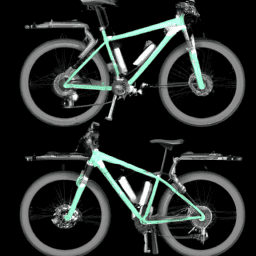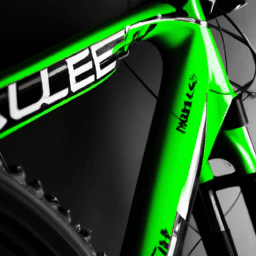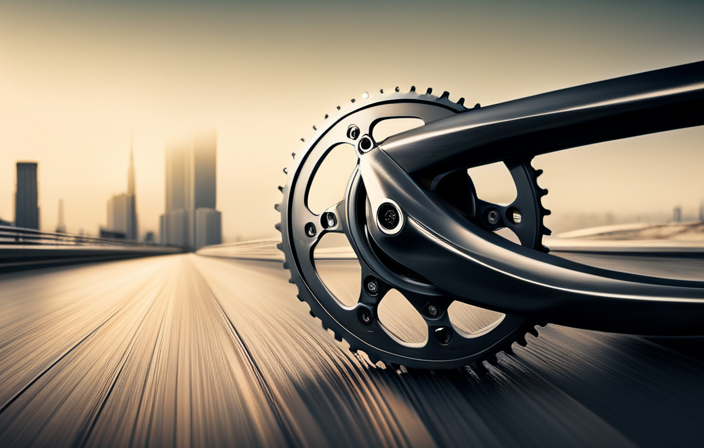Wondering about the maximum speed you can achieve on a bicycle? Several elements can impact your velocity, such as your physical condition, the landscape you’re cycling through, the current weather, and the model of bicycle you’re on.
By understanding these factors and taking steps to improve them, you can increase your speed and reach new levels of cycling performance.
Your fitness level is perhaps the most important factor in determining your cycling speed. The more fit you are, the easier it will be to pedal faster and maintain that speed for longer periods of time. This means that regular exercise, whether it’s cycling or other forms of cardio and strength training, can help you build the endurance and power you need to ride faster.
Additionally, your body weight can also play a role in your speed, as carrying excess weight can slow you down. By maintaining a healthy body weight and focusing on building your fitness, you can set yourself up for faster, more efficient cycling.
Key Takeaways
- Fitness level and regular exercise are crucial factors in determining cycling speed.
- Terrain and weather conditions can greatly affect speed, with uphill challenges requiring lower gear and consistent pedal stroke, and proper gear being important for rain.
- Aerodynamics and weight can greatly affect speed, reducing drag can increase speed by 15%, and body position, bike frame, and wheel size can reduce wind resistance.
- Gearing and proper bike fit are also crucial for efficient pedaling, reducing strain on legs and joints, and maximizing performance and comfort.
Fitness Level
You can’t ride a bike very fast if you’re not keeping up with your fitness level! This is because cycling requires a significant amount of energy and endurance. If you want to increase your cycling speed, you need to focus on improving your fitness level.
One way to do this is by engaging in workout routines that are specifically designed to target your cardiovascular system. This will help you build up your endurance and increase your overall fitness level. Another effective method for improving your cycling speed is by following a structured training program.
A training program will help you work on specific areas of your fitness level, such as endurance, strength, and speed. You can find a variety of training programs online or through a certified cycling coach. By following a structured training program, you can gradually increase your cycling speed and build up your endurance, which will help you tackle more challenging terrain.
Speaking of terrain, let’s take a look at how different types of terrain can affect your cycling speed.
Terrain
Navigating through rugged terrain can be a real uphill battle, even for the most experienced cyclists. Uphill challenges can be particularly difficult, as you’ll need to work harder to maintain your speed and momentum. In order to tackle steep inclines, you’ll need to shift into a lower gear, which will make it easier to pedal. Additionally, it’s important to maintain a consistent pedal stroke and body position to ensure efficient use of energy.
Remember to keep your weight centered over the bike and avoid leaning too far forward, as this can cause your front wheel to lift off the ground.
On the other hand, downhill thrills can be just as exciting as they are dangerous. When descending steep hills, it’s important to maintain a controlled speed and avoid sudden movements that could cause you to lose control. Always keep your eyes focused on the road ahead and anticipate any obstacles or changes in the terrain. As you gain speed, make sure to use your brakes sparingly and apply them evenly to avoid skidding or losing traction.
Remember, the key to successful cycling on rugged terrain is to stay focused, use proper technique, and maintain control at all times.
As you prepare to tackle the terrain, it’s important to consider how weather conditions may impact your ride.
Weather
Don’t let unexpected weather ruin your cycling adventure! When it comes to cycling in the rain, you’ll want to make sure you have the proper gear to keep you dry and comfortable. This includes investing in wind-resistant clothing, such as a jacket or pants, to prevent the chill from penetrating your clothes.
Additionally, consider wearing a helmet with a visor to keep rain out of your eyes and a pair of gloves to keep your hands warm and dry.
It’s important to note that cycling in the rain can be more dangerous than riding on a dry surface. Wet roads can be slick and slippery, making it harder to maintain control of your bike. Be sure to slow down and increase your following distance when riding in wet conditions.
With the right gear and precautions, you can still enjoy a ride in the rain without sacrificing safety or comfort. Now, let’s talk about the type of bike you should consider for your next cycling adventure.
Type of Bike
When it comes to choosing the right bike for your ride, you’ll want to consider a few key factors.
Road bikes are designed for speed and efficiency on smooth surfaces, while mountain bikes are built to handle rough terrain with ease.
Aerodynamics and weight are also important considerations, as they can greatly affect your speed and performance.
And don’t forget about gearing choosing the right combination of gears can make all the difference in your ride.
By keeping these factors in mind, you can choose the perfect bike for your needs and take your cycling to the next level.
Road Bikes vs. Mountain Bikes
Compared to mountain bikes, road bikes are designed for speed and efficiency on paved roads, but may not handle rough terrain as well.
Off road challenges, uphill battles, and rocky terrains can make mountain bikes a better choice for those who want to explore the great outdoors.
However, if you’re looking for speed and agility on smooth surfaces, road bikes are the way to go.
The thrill of the ride is not just about the destination, but also about the journey.
Exploring the adrenaline rush of fast cycling on different terrains with different bikes is an exciting experience.
Whether you’re racing down a mountain trail or cruising along a city street, the type of bike you choose can make all the difference.
In the next section, we’ll explore how aerodynamics and weight can play a crucial role in determining your cycling speed.
Aerodynamics and Weight
To improve your cycling speed, it’s important to consider the aerodynamics and weight of your bike. Wind resistance is a major factor in cycling, and reducing drag can lead to a 15% increase in speed.
To decrease wind resistance, focus on your body position while riding. A more aerodynamic position can make a significant difference in your speed. In addition to body position, the bike frame and wheel size also play a role in reducing wind resistance. A lightweight frame and smaller wheels are more aerodynamic and can increase your speed. However, it’s important to balance weight and aerodynamics, as a heavier bike can provide more stability and control.
By optimizing your bike’s aerodynamics and weight, you can increase your cycling speed and performance. With this in mind, let’s explore how gearing can further improve your speed.
Gearing
Optimizing your gears is a crucial aspect of improving your cycling speed and performance. Efficient pedaling is essential to ensure that you’re not wasting energy on unnecessary movements. When your bike has the right gear ratio, you can maintain a smooth and consistent cadence that allows you to pedal more efficiently. It also helps to reduce the strain on your legs and joints, preventing fatigue and injuries.
Cadence control is another vital factor when it comes to gearing. It refers to the number of revolutions your pedals make per minute. The ideal cadence for most cyclists is between 80 and 100 rpm. To achieve this, you need to find the right gear combination that suits your riding style and terrain.
With the correct gear ratio and cadence, you can ride faster and longer without overexerting yourself. When it comes to increasing your cycling speed, optimizing your gears is just one aspect of it. There are several other tips and tricks you can follow to improve your performance on the bike.
Tips for Increasing Speed
If you’re looking to increase your speed on a bike, there are a few key areas to focus on.
First and foremost, ensure that your bike is properly fitted to your body. This will help maximize your power output and minimize fatigue.
Additionally, pay close attention to your nutrition and hydration, as these factors can greatly impact your performance.
Finally, don’t forget about mental preparation and focus – staying positive and motivated can make a big difference in your speed and overall biking experience.
Proper Bike Fit
Achieving the proper bike fit is essential for maximum performance and comfort during your ride. Making adjustments to your bike can help you to ride faster and farther with less effort. Professional fitting services can be a great way to ensure that your bike is set up to fit your body perfectly. Here are some important adjustments to consider when trying to achieve the perfect fit:
| Adjustment | Importance |
|---|---|
| Saddle height | Proper height can improve power output and reduce fatigue |
| Handlebar position | Adjusting handlebars can reduce strain on the neck and shoulders |
| Cleat position | Proper placement can improve power transfer and reduce knee pain |
| Frame size | Choosing the right frame size can improve comfort and efficiency |
Having a bike that fits you properly can make all the difference in your riding experience. It can help you to avoid injuries and improve your overall performance on the bike. Once you have the proper fit, you can focus on other aspects of your cycling, such as nutrition and hydration, to help take your riding to the next level.
Nutrition and Hydration
Despite the fact that drinking water during a cycling session might sound counterintuitive, it’s essential to avoid dehydration and prevent cramps. Proper hydration and nutrition play a vital role in the performance of a cyclist.
Here are some points to consider before and after your ride:
-
Pre-ride meals: Eating a balanced meal 2-3 hours before the ride can help provide the necessary energy for the ride. Foods high in carbohydrates, such as whole-grain pasta or rice, can help maintain energy levels during the ride. Avoid high-fat and high-fiber foods as they can cause stomach discomfort.
-
Hydration during the ride: It’s essential to hydrate during the ride to avoid dehydration and cramps. Drink water or a sports drink every 15-20 minutes during the ride to maintain hydration levels.
-
Post-ride recovery: After the ride, it’s crucial to replenish the lost fluids and nutrients. Consuming a combination of carbohydrates and protein within 30 minutes of the ride can help restore energy levels and aid muscle recovery.
Incorporating these nutrition and hydration tips into your cycling routine can help improve your performance and reduce the risk of injuries. Mental preparation and focus are equally important for a successful ride.
Mental Preparation and Focus
Now that you’ve learned about the importance of nutrition and hydration in cycling, it’s time to focus on mental preparation and focus. Mental strength plays a crucial role in how fast and efficiently you can ride a bicycle.
Visualization techniques and breathing exercises are two important tools that can help you achieve the right mental state to maximize your performance.
Visualization techniques involve creating a mental image of yourself successfully completing a race or achieving your desired outcome. This technique helps to reduce anxiety and build confidence, which can enhance your overall performance.
Before a race, take some time to visualize yourself completing the course, overcoming obstacles, and crossing the finish line. This mental preparation can help you stay motivated and focused throughout the race.
Breathing exercises are another effective tool for improving your mental state and performance on the bike. Deep breathing can help you relax and reduce stress, which can improve your focus and decrease your heart rate.
Practice taking deep breaths before and during your ride to help maintain your mental clarity and focus. By incorporating visualization techniques and breathing exercises into your training regimen, you can develop a stronger mind-body connection, which can help you ride faster and more efficiently.
Frequently Asked Questions
What is the maximum speed a professional cyclist can achieve on a flat road?
You can achieve a maximum speed record of 56.6 mph on a flat road, but factors such as wind resistance, road conditions, and altitude can affect your speed. Professional cyclists train to optimize their performance and minimize these factors.
How much difference does the weight of the bike make in terms of speed?
The weight of a bike can significantly impact its speed, with lighter frames allowing for faster acceleration and easier maneuverability. Additionally, tire pressure can also affect speed, as lower pressure can increase rolling resistance. The choice of bike frame material can also impact speed, with carbon fiber frames being lighter and more aerodynamic, leading to faster rides.
Can wind speed affect the speed at which one can ride a bicycle?
Wind speed can greatly affect your cycling speed due to wind resistance. Aerodynamics play a key role in reducing drag and optimizing performance. Consider the direction and intensity of wind when planning your ride.
How much of an impact does the clothing a cyclist wears have on their speed?
To optimize cycling speed, consider the impact of clothing. Aerodynamic apparel minimizes drag while wicking fabric keeps you cool and dry. Strategize with technical data to enhance your performance on the bike.
Is it possible to achieve a higher speed on a stationary bike compared to a regular bike on the road?
You may be surprised to learn that stationary biking can offer advantages over road biking for speed training. However, techniques such as interval training and proper form can also improve speed on a regular bike.
Conclusion
Congratulations! You’ve learned the various factors that affect your cycling speed. It’s important to take into account your fitness level, the terrain you’ll be cycling on, the weather, and the type of bike you’re using.
By understanding these factors, you can make adjustments to your training and gear to improve your speed and endurance. Remember, increasing your speed is not just about pushing yourself harder, but about training smart and efficiently.
Focus on building your endurance, maintaining good form, and optimizing your bike setup. And don’t forget to use the tips we’ve provided to help you push your limits and reach your cycling goals.
As the great cyclist, Greg LeMond once said, "It never gets easier, you just get faster."So keep pushing yourself, stay motivated, and enjoy the ride.
Happy cycling!
















